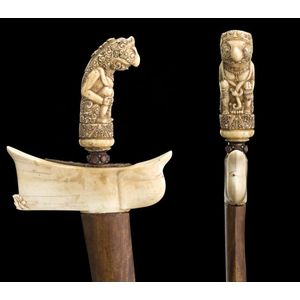Meiji Ivory Tanto with Rural Scene Relief Carving
You must be a subscriber, and be logged in to view price and dealer details.
Subscribe Now to view actual auction price for this item
When you subscribe, you have the option of setting the currency in which to display prices to $Au, $US, $NZ or Stg.
- Ivory - Ivory is a hard white material that comes from the tusks of elephants, mammoth, walrus and boar, or from the teeth of hippopotamus and whales. The ivory from the African elephant is the most prized source of ivory. Although the mammoth is extinct, tusks are still being unearthed in Russia and offered for sale.
Ivory has been used since the earliest times as a material for sculpture of small items, both in Europe and the east, principally China and Japan.
In Asia ivory has been carved for netsuke, seals, okimono, card cases, fan supports, animals and other figures and even as carved tusks.
In the last 200 years in Europe ivory has been used to carve figures, for elaborate tankards, snuff boxes, cane handles, embroidery and sewing accessories, in jewellery and as inlay on furniture. Its more practical uses include being used for billiard balls, buttons, and a veneers on the top of piano keys.
The use and trade of elephant ivory have become controversial because they have contributed to Due to the decline in elephant populations because of the trade in ivory, the Asian elephant was placed on Appendix One of the Convention on International Trade in Endangered Species (CITES), in 1975, and in January 1990, the African elephant was similarly listed. Under Appendix One, international trade in Asian or African elephant ivory between member countries is forbidden. Unlike trade in elephant tusks, trade in mammoth tusks is legal.
Since the invention of plastics, there have been many attempts to create an artificial ivory
This item has been included into following indexes:
Visually similar items

An 18ct white gold and diamond lady's Rolex wristwatch, single cut diamond set dial, painted Rolex symbol underside of glass on a Rolex 19 jewel manual movement no. 1400, case marked Rolex 2628, outside with Rolex symbol, no. 2612910 on back in an 18ct whi

North Java, kris and scabbard, possibly 9th?11th century, steel blade decorated on each side in relief with three standing priest figures and a winged elephant, the scabbard of wood with a modelled ivory crosspiece; the bone hilt carved in the form of a de

An old Malekula wood Grade figure, Vanuatu. Provenance: David Baker Collection. 163 cm

Barbara Tribe 'Anatomical Foot' (1965) well sculptured mid 20th century anatomical foot by acclaimed artist Barbara Tribe. Featuring the left foot showing the interior mechanics of the foot. Signed to base, height 13 cm, width 25 cm, depth 10 cm
